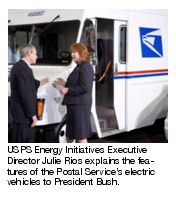 The Postal Service has a long history of exploring cleaner, more energy-efficient ways to deliver the nation’s mail. It boasts the nation’s largest fleet of alternate-fuel vehicles — some 38,000 cars, trucks and minivans — powered by electricity, compressed natural gas, liquid propane gas, ethanol (E85), biodiesel fuel and hydrogen fuel cells.
The Postal Service has a long history of exploring cleaner, more energy-efficient ways to deliver the nation’s mail. It boasts the nation’s largest fleet of alternate-fuel vehicles — some 38,000 cars, trucks and minivans — powered by electricity, compressed natural gas, liquid propane gas, ethanol (E85), biodiesel fuel and hydrogen fuel cells.
Recently, USPS participated in a White House event promoting alternate-fuel technology, demonstrating the technology behind two zero-emissions mail-delivery vehicles — a hydrogen fuel-cell minivan and an electric two-ton truck.
The Postal Service has been collecting and analyzing data from a General Motors HydroGen3 hydrogen fuel-cell minivan delivering mail in the Washington, DC, area since 2005 and one delivering in Irvine, CA, since September 2006. Hydrogen fuel-cell vehicles emit just pure water and are twice as energy efficient as internal combustion engine vehicles.
Thirty two-ton zero-emissions electric vehicles have been delivering mail in New York City since 2004. The CitiVans are powered by a series of lead-acid batteries constructed from sealed gel modules that don’t require water replacement or other maintenance during their service life.
Postal Service engineers say that both the HydroGen3 minivans and the CitiVans have been holding up well to the rigors of stop-and-go driving and hot and cold weather conditions.
